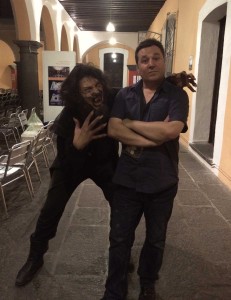
In Lost Soul: The Doomed Journey of Richard Stanley’s Island of Dr. Moreau, documentarian David Gregory ventured into uncharted territory: he was accounting for what actually happened during pre-production and especially principal photography on the 1996 film. For Gregory, the key to the tale was gaining full access to Richard Stanley, an English director who until that point had been mostly known for directing the low-budget 1990 sci-fi film Hardware. “I’ve been aware of Richard Stanley since the world premiere of Hardware in Shock Around the Clock in London,” Gregory said from Southern California, where he’s currently touring with his documentary. “I was excited to see what he was going to do next. Moreau was going to be pretty exciting. The late 1990s were a lame time for horror films. Moreau was really king of perverse and I thought Richard was going to handle it beautifully.”
Gregory and Stanley had already formed a relationship as the former’s company Severin Films had released Hardware on Blu-ray. In the intervening years, there had been several projects which Stanley had written but had been unable to get off of the ground. He also served as a co-writer on the other’s films. The two remained in touch, piquing Gregory’s interest when Stanley directed Mother of Toads, one of seven in a 2011 home video horror anthology called Theatre Bizarre.
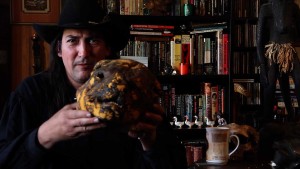
In the 1990s, with something of an unprecedented independent film explosion occurring (especially with the success of projects from directors including Richard Linklater, Kevin Smith, Quentin Tarantino and Robert Rodriguez), Hardware indicated to Gregory that Stanley showed great potential, thus Stanley became a natural for a feature-length documentary with his original vision for a grandiose Moreau. “I had made quite a lot of behind-the-scenes documentaries,” Gregory noted. “This was the first time that I thought it could be its own movie. It was labyrinthine, the things that were going through my head. [The story included] everyone from the studio head to the production runners, but it’s mainly Richard’s story. His exciting career became suddenly halted.”
Considering all that transpired within Stanley’s Moreau, leading to his eventual dismissal from the film, Gregory ascribed the first serious problem being one of political posturing. “Richard was operating within the studio system,” he offered. “Hardware was a low-budget indie. I’m not saying Richard couldn’t have handled a studio film. When I first saw Peter Jackson’s Bad Taste and Braindead, I was super excited. That’s what I want those talents to be doing, rather than be hampered by a huge studio budget. [Regarding Stanley’s second feature] Dust Devil – Palace Pictures went out of business when he was making it. It wasn’t as tight a film as Hardware.”
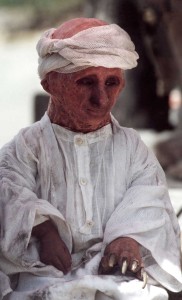 Certainly, stepping up to a studio production with Moreau, one noteworthy element was the addition to the cast of Marlon Brando and Val Kilmer, moves which alone might have sealed Stanley’s fate. “It seems that once they got Brando and Kilmer, it became this huge-budget production,” Gregory said. “Their minds were already made up that they needed to replace Stanley with a veteran. They needed a movie completed, not a perverse little horror movie.”
Certainly, stepping up to a studio production with Moreau, one noteworthy element was the addition to the cast of Marlon Brando and Val Kilmer, moves which alone might have sealed Stanley’s fate. “It seems that once they got Brando and Kilmer, it became this huge-budget production,” Gregory said. “Their minds were already made up that they needed to replace Stanley with a veteran. They needed a movie completed, not a perverse little horror movie.”
Gregory himself recalls that after finishing film school in Los Angeles in 1996, he picked up a copy of the LA Weekly and saw that director John Frankenheimer was attached to the Moreau production. Alas, even old-guard Frankenheimer was unable to rescue the sinking Moreau. “I’m not sure anyone could have survived that situation,” Gregory related. “Frankenheimer was a veteran known for dealing with difficult actors. I don’t think Richard was aware of what he was getting himself into. His greenness working on big budget productions was the problem. He’s not thinking that Marlon Brando is costing x dollars per day. If there was any fault of Richard’s — it was dealing with large-scale problems.”
As Moreau ascended from a small project to a major release with two notoriously difficult actors, Gregory noted that Stanley might have eventually faded even if he was kept on the project during principal photography. Not helping Stanley’s plight at the time were reports that Stanley was refusing to leave the house he was renting near the set. “It was in their minds that Richard was a kooky artist,” said Gregory of New Line and founder Robert Shaye, who comments on the project throughout Lost Soul. “They would have let it go if it was a $5 million film. Secondly, and Richard is quite adamant about this, is that he didn’t drive – therefore, it wasn’t that he refused to leave his house; they weren’t sending cars to pick him up. That’s what he claimed. ‘All of this shit is happening without me being there.’”
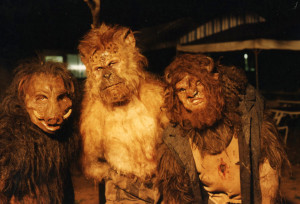 When Stanley lived in Los Angeles before Moreau’s crew moved to the Australian location, he walked everywhere, according to Gregory, which might have been a tell-tale sign; nonetheless, Gregory insisted that Stanley likely would have been replaced regardless.
When Stanley lived in Los Angeles before Moreau’s crew moved to the Australian location, he walked everywhere, according to Gregory, which might have been a tell-tale sign; nonetheless, Gregory insisted that Stanley likely would have been replaced regardless.
Among the strange events surrounding Stanley and Moreau was the reality that he never got on a plane in Australia to return home – his whereabouts during the ensuing Moreau production with Frankenheimer in control were unknown. In Gregory’s film, we finally learn the truth about the ongoing rumors, that Stanley stayed in a campsite near the Moreau set and in fact snuck back onto the production under clandestine circumstances, wearing an animal mask and actually appearing on film as an extra. “Richard, since I’ve known him, he likes to live in remote places,” Gregory said. “He goes on walkabouts a couple of days at a time and lives in caves. It doesn’t surprise me, getting your dream project taken away, that he said, ‘Screw this, I’m going to live in the forest for a while and get away from the madness of the First World.’”
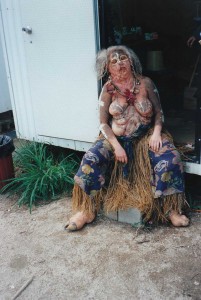 One of the legacies of the finally released 1996 Moreau was its nearly complete absence of cohesion despite the addition of Frankenheimer as director, the award-winning Stan Winston Studio designing the human/animal hybrid creatures, and the name talent in the cast, but Gregory noted that such a misconstrued final product might have resulted regardless of its director. “I don’t think anyone could have salvaged the film,” he said. “Kilmer was going through some personal problems. Richard doesn’t blame Kilmer. You throw a shark in a pool with a bunch of meat, he’s going to eat it — he’s going to act like the spoiled child. Brando was famous for being difficult. He was never disrespectful to the crew as Kilmer was. Double whammy of those two warring egos.”
One of the legacies of the finally released 1996 Moreau was its nearly complete absence of cohesion despite the addition of Frankenheimer as director, the award-winning Stan Winston Studio designing the human/animal hybrid creatures, and the name talent in the cast, but Gregory noted that such a misconstrued final product might have resulted regardless of its director. “I don’t think anyone could have salvaged the film,” he said. “Kilmer was going through some personal problems. Richard doesn’t blame Kilmer. You throw a shark in a pool with a bunch of meat, he’s going to eat it — he’s going to act like the spoiled child. Brando was famous for being difficult. He was never disrespectful to the crew as Kilmer was. Double whammy of those two warring egos.”
Another outstanding revelation in Gregory’s film is the misbehavior of the extras, who, playing the animalistic background characters, hot and overworked, went to excesses after each day’s shooting. “The extras were all partying,” Gregory detailed. “So many elements made it an impossible film to make. Not even Francis Coppola could have done it. He rejuvenated Brando’s career with The Godfather, but even he couldn’t coerce him on Apocalypse Now. You get Brando, you do it the way he wants.”
Indeed, though it remains unthinkable to the lay viewer, Brando is noted by a crewmember for his “legendary contempt for his own profession.”
“You know whether it’s somebody in the cast or crew, not playing along, once that cancer starts, it spreads down into the departments,” Gregory remarked. “Everybody starts having disrespect. It’s hard enough without all of the problems that they brought to that set.”
In addition to locating reviews and articles from the Motion Picture Academy Library and various magazines, in order to track down the principals – with the exceptions of Brando and Frankenheimer who had passed before Lost Soul began production – it took Gregory three years of work while running his own label, releasing other independent films, and creating featurettes for Blu-rays. “I had the luxury of tracking people down,” he said. “There was a handful of people who didn’t want anything to do with it. For the most part, people had such a fascinating experience, they wanted to do it. I usually had a cameraman while I was doing the interviews. I hired film students from a school in Brisbane to interview people in Sydney. There was lots of collaborators, many of whom I never actually met.”
In screenings thus far, Gregory has been pleased with the general audience’s reaction to this very specific inside-show-business story. “The reviews so far and the audience response has been very good,” Gregory responded. “Richard has been on our side promoting it. He’s not 100% happy with the film. We get along, so it’s actually been a lot of fun.”
Lost Soul screens theatrically during March in 12 different cities around the U.S. in addition to its general release via On Demand and iTunes. There will be a DVD and Blu-ray coming out in May with outtakes and additional stories.





